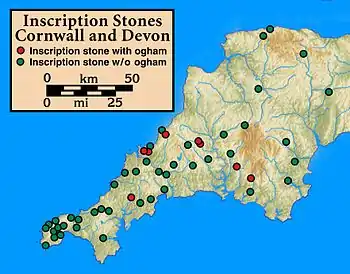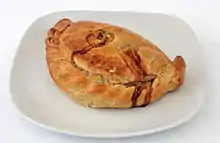Portal:Cornwall
 Location of Cornwall Cornwall (/ˈkɔːrnwɔːl, -wəl/; Cornish: Kernow [ˈkɛrnɔʊ]) is a historic county and ceremonial county in South West England. It is recognised as one of the Celtic nations, and is the homeland of the Cornish people. Cornwall is bordered to the north and west by the Atlantic Ocean, to the south by the English Channel, and to the east by the county of Devon, with the River Tamar forming the border between them. Cornwall forms the westernmost part of the South West Peninsula of the island of Great Britain. The southwesternmost point is Land's End and the southernmost Lizard Point. Cornwall has a population of 568,210 and an area of 3,563 km2 (1,376 sq mi). The county has been administered since 2009 by the unitary authority, Cornwall Council. The ceremonial county of Cornwall also includes the Isles of Scilly, which are administered separately. The administrative centre of Cornwall is Truro, its only city. Cornwall was formerly a Brythonic kingdom and subsequently a royal duchy. It is the cultural and ethnic origin of the Cornish diaspora. The Cornish nationalist movement contests the present constitutional status of Cornwall and seeks greater autonomy within the United Kingdom in the form of a devolved legislative Cornish Assembly with powers similar to those in Wales, Scotland and Northern Ireland. In 2014, Cornish people were granted minority status under the European Framework Convention for the Protection of National Minorities, giving them recognition as a distinct ethnic group. Recent discoveries of Roman remains in Cornwall indicate a greater Roman presence there than once thought. After the collapse of the Roman Empire, Cornwall (along with Devon, parts of Dorset and Somerset, and the Scilly Isles) was a part of the Brittonic kingdom of Dumnonia, ruled by chieftains of the Cornovii who may have included figures regarded as semi-historical or legendary, such as King Mark of Cornwall and King Arthur, evidenced by folklore traditions derived from the Historia Regum Britanniae. The Cornovii division of the Dumnonii tribe were separated from their fellow Brythons of Wales after the Battle of Deorham in AD 577, and often came into conflict with the expanding English kingdom of Wessex. The regions of Dumnonia outside of Cornwall (and Dartmoor) had been annexed by the English by AD 838. King Athelstan in 936 AD set the boundary between the English and Cornish at the high water mark of the eastern bank of the River Tamar. From the Early Middle Ages, language and culture were shared by Brythons trading across both sides of the Channel, resulting in the corresponding high medieval Breton kingdoms of Domnonée and Cornouaille and the Celtic Christianity common to both areas. Cornwall is noted for its geology and coastal scenery. A large part of the Cornubian batholith is within Cornwall. The north coast has many cliffs where exposed geological formations are studied. The area is noted for its wild moorland landscapes, its long and varied coastline, its attractive villages, its many place-names derived from the Cornish language, and its very mild climate. Extensive stretches of Cornwall's coastline, and Bodmin Moor, are protected as an Area of Outstanding Natural Beauty. (Full article...) Selected article Cornish (Standard Written Form: Kernewek or Kernowek; [kəɾˈnuːək]) is a Southwestern Brittonic language of the Celtic language family. It is a revived language, having become extinct as a living community language in Cornwall at the end of the 18th century. However, knowledge of Cornish, including speaking ability to a certain extent, continued to be passed on within families and by individuals, and a revival began in the early 20th century. The language has a growing number of second language speakers, and a very small number of families now raise children to speak revived Cornish as a first language. Cornish is currently recognised under the European Charter for Regional or Minority Languages, and the language is often described as an important part of Cornish identity, culture and heritage. Along with Welsh and Breton, Cornish is descended from the Common Brittonic language spoken throughout much of Great Britain before the English language came to dominate. For centuries, until it was pushed westwards by English, it was the main language of Cornwall, maintaining close links with its sister language Breton, with which it was mutually intelligible, perhaps even as long as Cornish continued to be spoken as a vernacular. Cornish continued to function as a common community language in parts of Cornwall until the mid 18th century. There is some evidence of knowledge of the language persisting into the 19th century, possibly almost overlapping the beginning of revival efforts. A process to revive the language began in the early 20th century, and in 2010, UNESCO announced that its former classification of the language as "extinct" was "no longer accurate." Since the revival of the language, some Cornish textbooks and works of literature have been published, and an increasing number of people are studying the language. Recent developments include Cornish music, independent films and children's books. A small number of people in Cornwall have been brought up to be bilingual native speakers, and the language is taught in schools and appears on road signs. The first Cornish-language day care opened in 2010. (Full article...)Selected biography King Mark of Cornwall, drawn by Howard Pyle in 1905
Did you know?
Selected quoteSelected picture
General imagesThe following are images from various Cornwall-related articles on Wikipedia.
WikiProjects
Related portalsTopicsHistory
Geography*Geography - Geology - Flora and fauna - Special Areas of Conservation - Sites of Special Scientific Interest
Politics
Economy and demographicsCulture
Subcategories
Category puzzle Select [►] to view subcategories
Cornwall Cornwall-related lists Buildings and structures in Cornwall Burials in Cornwall Cornish culture Crime in Cornwall Culture in Cornwall Deputy Lieutenants of Cornwall Duchy of Cornwall Economy of Cornwall Education in Cornwall Entertainment in Cornwall Environment of Cornwall Films shot in Cornwall Flags of Cornwall Geography of Cornwall Geology of Cornwall Health in Cornwall Hilda Annetta Walker, Cornish river scene History of Cornwall Cornish language Lizard Peninsula Local government in Cornwall Mass media in Cornwall Organisations based in Cornwall Cornish people People from Cornwall Politics of Cornwall Religion in Cornwall Science and technology in Cornwall Cornish society Sport in Cornwall Tourist attractions in Cornwall Transport in Cornwall Cornwall stubs Recognised content
Featured articlesMain page featured articlesFeatured listsGood articles
Former good articlesGood article nomineesIn the News articlesThings you can do'
Associated WikimediaThe following Wikimedia Foundation sister projects provide more on this subject:
Wikipedia in CornishDiscover Wikipedia using portals
| |||||||||||||||||||||||||||||||





.jpg.webp)











_(14591082390).jpg.webp)
















_-_BL_Stowe_MS_944%252C_f_30v.jpg.webp)






